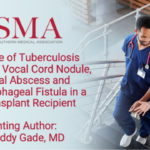Abstract | November 6, 2020
A Rare Case of Tuberculosis Presenting as Vocal Cord Nodule, Submental Abscess and Tracheoesophageal Fistula in a Renal Transplant Recipient
Introduction: Among transplant recipients, atypical bacterial infections are not uncommon. Tuberculosis (TB) can have unusual manifestations, especially in immunocompromised hosts. Diagnosis of TB should be considered if a patient born in TB-endemic area presents with unusual symptoms. Upper respiratory involvement of TB is rare and can include granulomatous lesion of nasopharynx, epiglottis, larynx etc. Esophageal manifestation of TB although rare can be challenging to diagnose and requires prompt treatment to prevent complications.
Case Report: A 72 year old Hispanic Male received a deceased donor renal transplant in May 2018 for end stage renal disease secondary to long-standing hypertension and type 2 diabetes mellitus. He was maintained on triple immunosuppressive regimen of Tacrolimus, Mycophenolate and Prednisone with excellent renal allograft function. In July 2019, he presented with hoarseness of voice. Direct laryngoscopic evaluation revealed a left vocal cord cystic lesion. Excision biopsy revealed caseating granulomas. AFB and fungal stains were negative. In September 2019, he presented with swelling under chin. CT showed submental abscess. He underwent I&D and treated with empiric antibacterial therapy given negative bacterial cultures. In October 2019, he presented with cough particularly following ingestion of liquids. He also reported dysphagia to both solids and liquids. An esophagogram was performed which revealed tracheoesophageal (TE) fistula. CT chest showed left lower lobe aspiration pneumonia. EGD and bronchoscopy confirmed TE fistula and biopsies were obtained that showed acute inflammation and negative for malignancy. TE fistula was repaired surgically. Given patient born in TB endemic area as well as exposed to family members travelling to Mexico, immunosuppressed & unexplained granulomatous vocal cord lesion, submental abscess and TE fistula, TB was suspected. Serial induced sputum samples were obtained. AFB stain and culture were positive and PCR confirmed M. tuberculosis species. He was initiated on regimen of Isoniazid, Pyrazinamide, Ethambutol and Levofloxacin. Rifampin was avoided given drug-drug interaction issues with Tacrolimus. Unfortunately, he developed dehiscence of TE fistula repair requiring esophagectomy, mobilization of serratus muscle flap and end esophagostomy. Pathology of esophagectomy specimen revealed transmural defect with acute, chronic and granulomatous inflammation. AFB stain was positive for acid fast bacilli. He required 2 subsequent chest washouts after and currently convalescing.
Discussion: We present an interesting and unusual case of upper respiratory tract and esophageal TB without involvement of lungs. These manifestations are rare and if undiagnosed can be life threatening especially in immunocompromised patients. Isolated lesions affecting the upper respiratory tracts are usually due to inhaled spores. Endoscopy with histopathological examination can help in establishing the diagnosis. Esophageal manifestations of TB should be treated promptly with antituberculous therapy as delay in diagnosis can lead to esophageal stenosis, ulcerations and TEF formation which require extensive surgical interventions like in our case.

